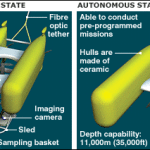Unlike other marine environments, the threats to the deep sea and it species are relatively new. Only recently has it been both economically and technologically feasible to exploit this environment. This means we have the unique opportunity to instigate conservation policy at the beginning, before drastic damage has been done, instead of trying to restore damaged habitats. Although action needs to be quick.
Reuters reports this…
Deep-sea fishing trawlers are bulldozing 4,500 year-old cold water coral reefs off western Ireland, a British marine biologist said on Monday. Dr Jason Hall-Spencer, of the University of Plymouth in southern England, told an international science conference urgent measures were needed to preserve the spectacular kilometre-deep coral and unusual organisms that thrive in the ocean depths. “Some of these areas have yet to be explored, but even before we have had a chance to see their treasures, they are being bulldozed by deep-water trawling. It is crucial that we take steps to protect the coral reefs before it is too late,” he said. Despite calls for international efforts to stop fishing nations from ravaging ocean beds and destroying cold-water coral, Hall-Spencer said there was no protection for the reefs located 85 kilometres (53 miles) off the Irish coast. He estimated that about 40 percent of the coral reefs had been destroyed. “Protection is needed now,” said Hall-Spencer. “The idea is to get in quick to preserve the few bits that are left.
This highlights the greatest threat to the deep sea, bottom trawling. As Smith and Glover (2003) note, “Low productivity, low physical energy, low biological rates, and the vastness of the soft-sediment deep sea create an unusual suite of conservation challenges relative to shallow water. The numerous, but widely spaced, island habitats of the deep ocean (for example seamounts, hydrothermal vents and submarine canyons) differ from typical deep-sea soft sediments in substrate type (hard) and levels of productivity (often high); these habitats will respond differently to anthropogenic impacts and climate change.” One of the many important points here is the low biological rates. In deep-sea fish, including commercially important ones, lifespans are long and growth is slow. Meaning that sustainable fisheries are not an option in deep-sea habitats. As Haedrich states, deep-sea fishing is the equivalent of strip mining. Of course, this is only one of the threats to the deep sea. Smith and Glover (2003) also list the following threats
Past Impacts
Dumping of oil/gas structures
Radioactive waste disposal
Lost nuclear reactors
Dumping of munitions
Present Impacts
Deep-sea fisheries
Collateral damage of trawling
Deep-sea oil and gas drilling
Dumping of bycatch causing food falls
Research and bioprospecting on vents
Underwater noise
Future Impacts
Polymetallic nodule mining
CO2 sequestration
Dumping of sewage sludge
Dumping of dredge spoil
Climate change
Manganese crust mining
Polymetallic sulphide mining
Methane hydrate extraction
…so what can you do? Visit the DeepSea Conservation Coalition Website
Share the post "ARCHIVE: 25 Things You Should Know About the Deep Sea: #6 The Deep Sea is Under Threat and Needs Protection"





